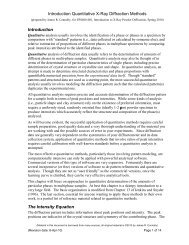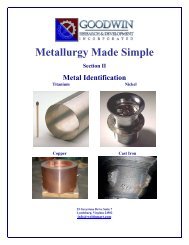Metallography and Microstructures of Cast Iron
Metallography and Microstructures of Cast Iron
Metallography and Microstructures of Cast Iron
Create successful ePaper yourself
Turn your PDF publications into a flip-book with our unique Google optimized e-Paper software.
578 / <strong>Metallography</strong> <strong>and</strong> <strong>Microstructures</strong> <strong>of</strong> Ferrous Alloysthe eutectic carbides indicate regions with alower concentration <strong>of</strong> carbide-forming elements,such as carbon <strong>and</strong> chromium, <strong>and</strong> perhapsa higher concentration <strong>of</strong> elements that arenot present in the carbides, such as silicon <strong>and</strong>nickel.Figure 43 shows the microstructure <strong>of</strong> a highchromiumcast iron after etching with glyceregia,revealing columnar primary carbides <strong>and</strong> eutecticcarbides, both (FeCr) 7 C 3 type, uniformlydistributed in the matrix. Figure 44 shows themicrostructure <strong>of</strong> the same specimen after etchingwith the st<strong>and</strong>ard Murakami’s etchant atroom temperature. The carbides are tinted an orangecolor, while the matrix is not colored. X-ray diffraction determined that the matrix wasaustenitic-ferritic; the matrix was not colored usingthe LB I tint etchant due to missing nickelin that iron.The basic etchants mentioned previously,which are suitable for revealing microstructuresas well as for phase identification in irons, arelisted in Table 2.Dark-Field Illumination <strong>and</strong> DifferentialInterference Contrast. Dark-field illumination(DFI) technique for microstructural examinationproduces a very strong image contrast that makesit possible to see features in the microstructurethat are invisible or weakly visible in bright-fieldillumination (BFI) when the surface <strong>of</strong> the specimenis normal to the optical axis <strong>of</strong> the microscope<strong>and</strong> white light is used. This image contrastis a result <strong>of</strong> reversing the image, which isbright in BFI, into a dark one when DFI is used.Table 3 Constituents commonly found incast iron microstructures, <strong>and</strong> their generaleffect on physical propertiesFig. 57 Compacted graphite examined with SEM. Samplewas deeply etched with 50% HCl. 1500Fig. 58 Hypoeutectic as-cast gray iron (Fe-2.8%C-1.85%Si-0.5%Mn-0.04%P-0.025%S).graphite type A. As-polished. 100FlakeFig. 59 Hypoeutectic as-cast gray iron (Fe-2.1%C-2.8%Si-0.38%Mn-0.06%P-0.03%S).graphite type D. As-polished. 100FlakeFig. 60 Hypereutectic as-cast gray iron (Fe-3.5%C-2.95%Si-0.4%Mn-0.08%P-0.02%S-0.13%Ni-0.15%Cu). Flake graphite type A. As-polished. 100ConstituentGraphite(hexagonalcrystalstructure)Austenite (c-iron)Ferrite (-iron)Cementite (Fe 3C)PearliteMartensiteSteadite(phosphorouseutectic)LedeburiteSource: Ref 3, 10Characteristics <strong>and</strong> effectsFree carbon; s<strong>of</strong>t; improvesmachinability <strong>and</strong> dampingproperties; reduces shrinkage <strong>and</strong>may reduce strength severely,depending on shapeFace-centered cubic crystal structure.The character <strong>of</strong> the primary phase,which solidifies from theoversaturated liquid alloy indendrite form, is maintained untilroom temperature. Austenite ismetastable or stable equilibriumphase (depending upon alloycomposition). Usually transformsinto other phases. Seen only incertain alloys. S<strong>of</strong>t <strong>and</strong> ductile,approximately 200 HBBody-centered cubic crystal structure.<strong>Iron</strong> with elements in solidsolution, which is a stableequilibrium, low-temperaturephase. S<strong>of</strong>t, 80–90 HB; contributesductility but little strengthComplex orthorhombic crystalstructure. Hard, intermetallic phase,800–1400 HV depending uponsubstitution <strong>of</strong> elements for Fe;imparts wear resistance; reducesmachinabilityA metastable lamellar aggregate <strong>of</strong>ferrite <strong>and</strong> cementite due toeutectoidal transformation <strong>of</strong>austenite above the bainite region.Contributes strength withoutbrittleness; has good machinability,approximately 230 HBGeneric term for microstructures thatform by diffusionlesstransformation, where the parent<strong>and</strong> product phases have a specificcrystallographic relationship. Hardmetastable phaseA pseudobinary or ternary eutectic <strong>of</strong>ferrite <strong>and</strong> iron phosphide orferrite, iron phosphide, <strong>and</strong>cementite, respectively. It can formin gray iron or in mottled iron witha phosphorous content 0.06%.Hard <strong>and</strong> brittle; solidifies from theliquid on cooling at the cellboundaries as a last constituent <strong>of</strong>the microstructureMassive eutectic phase composed <strong>of</strong>cementite <strong>and</strong> austenite; austenitetransforms to cementite <strong>and</strong>pearlite on cooling. Produces highhardness <strong>and</strong> wear resistance;virtually unmachinable








